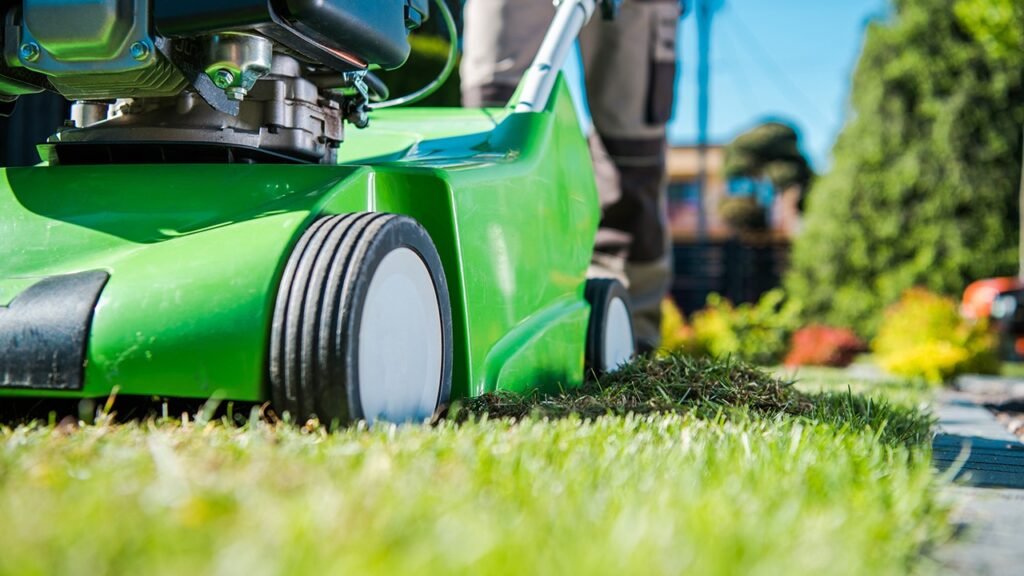Welcome to this article, where we will be discussing the topic of green landscaping and zero emission tools for eco-conscious gardens. Throughout the article, you will learn about the importance of embracing green practices in landscaping, as well as the benefits of using zero emission tools. We will explore how these tools can help create more environmentally friendly and sustainable gardens, and provide tips on how to incorporate them into your own landscaping routine. So, let’s dive in and discover how you can make your garden greener without compromising on efficiency or effectiveness. Green landscaping is a practice that promotes eco-friendly and sustainable techniques to create and maintain outdoor spaces. It emphasizes reducing the environmental impact of landscaping activities and maximizing the benefits for both the environment and individuals. By implementing green landscaping principles, individuals can contribute to a healthier planet while enjoying the beauty and functionality of their outdoor spaces.
Definition of Green Landscaping
Green landscaping, also known as sustainable landscaping or eco-friendly landscaping, involves using environmentally friendly practices to design, construct, and maintain outdoor spaces. It aims to minimize the use of resources like water and energy, reduce waste and pollution, and enhance the overall health and well-being of the surrounding ecosystem.
Importance of Green Landscaping
Green landscaping plays a crucial role in promoting environmental sustainability and conservation. By adopting green landscaping practices, individuals can:
-
Reduce environmental impact: Traditional landscaping practices often rely on the excessive use of water, synthetic fertilizers, and harmful pesticides, which can have detrimental effects on the environment. Green landscaping aims to minimize these impacts, leading to improved overall environmental health.
-
Improved air quality: Green landscaping involves planting trees, shrubs, and other vegetation that can filter pollutants from the air and provide cleaner oxygen. By implementing green landscaping, individuals can help combat air pollution and create a healthier atmosphere.
-
Conservation of water resources: Water scarcity is a significant concern in many regions globally. Green landscaping practices, such as using native plants and installing efficient irrigation systems, can help conserve water resources by minimizing water waste and promoting optimal water usage.
-
Enhanced biodiversity: Traditional landscaping practices often focus on ornamental plants that provide limited benefits to local wildlife and biodiversity. Green landscaping, on the other hand, emphasizes the use of native plants that can support local ecosystems and attract beneficial insects, birds, and other wildlife.
The benefits of green landscaping extend beyond the use of sustainable practices. Zero emission tools are an essential component of a green landscaping toolkit that can further enhance the eco-friendliness of outdoor maintenance activities.
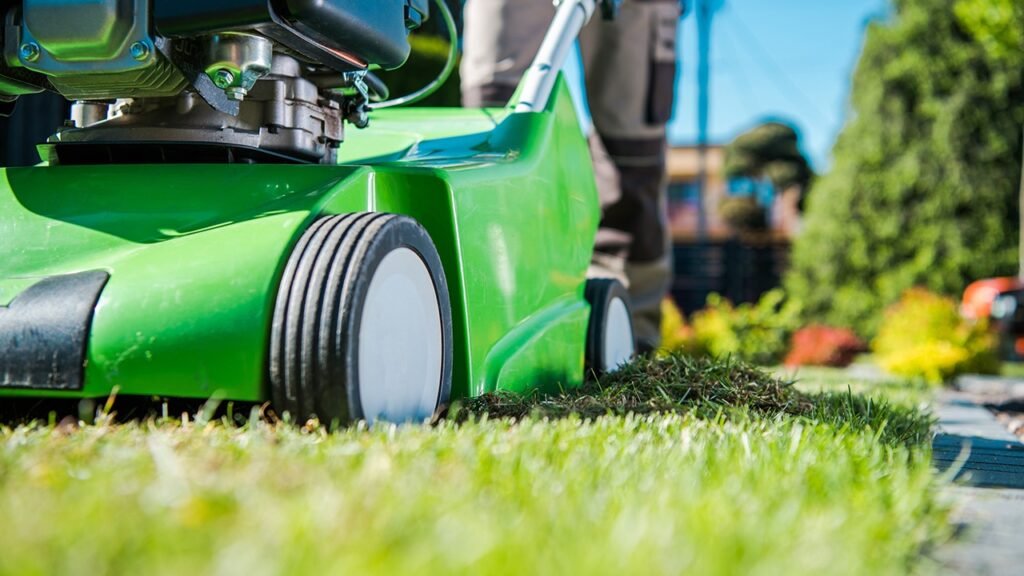
This image is property of www.ecogardeners.com.
Introduction to Zero Emission Tools
Zero emission tools, as the name suggests, are landscaping equipment that produces zero or minimal emissions during operation. These tools are designed to reduce air and noise pollution while still providing efficient and effective landscaping capabilities. By using zero emission tools, individuals can significantly reduce their carbon footprint, contribute to cleaner air, and decrease noise pollution in their neighborhoods.
What are Zero Emission Tools?
Zero emission tools are electric-powered landscaping equipment that relies on rechargeable batteries instead of traditional gasoline or diesel engines. These tools use advanced battery technology to provide comparable performance to their gas-powered counterparts while emitting zero or significantly reduced levels of pollutants.
Types of Zero Emission Tools
-
Zero Emission Lawn Mowers: Zero emission lawn mowers are electric mowers that eliminate the need for gasoline or diesel fuel. They are often battery-powered and provide a quiet and pollution-free alternative to traditional gas-powered mowers.
Features of Zero Emission Lawn Mowers
- Rechargeable battery-powered
- Quiet operation
- Easy to start and operate
- Reduced maintenance requirements
Advantages of Zero Emission Lawn Mowers
- Zero emissions: Zero emission lawn mowers eliminate the release of harmful pollutants into the atmosphere, contributing to cleaner air quality and reducing environmental impact.
- Noise reduction: Compared to gas-powered mowers, zero emission lawn mowers operate quietly, minimizing noise pollution and creating a more peaceful outdoor environment.
- Lower operating costs: While the initial investment may be higher, the ongoing operating costs of zero emission lawn mowers are significantly lower due to the absence of fuel requirements.
-
Zero Emission Trimmers and Edgers: Zero emission trimmers and edgers are electric-powered tools used for maintaining the edges of lawns, hedges, and shrubs. These tools are lightweight, easy to handle, and offer precise trimming capabilities.
Benefits of Zero Emission Trimmers
- Reduced environmental impact: Zero emission trimmers produce no direct emissions, reducing air pollution and contributing to a healthier environment.
- Quiet operation: These tools operate quietly, minimizing noise disturbances for both the user and the surrounding neighborhood.
- Ease of use: Electric trimmers are generally lighter and easier to maneuver than their gas-powered counterparts, making them more user-friendly.
Efficiency of Zero Emission Edgers
Zero emission edgers provide precise cutting and defining of lawn edges, ensuring a neat and well-maintained appearance. With powerful battery technology, these tools offer comparable performance to gas-powered edgers while eliminating emissions and reducing maintenance requirements.
-
Zero Emission Leaf Blowers: Leaf blowers are commonly used to clear leaves and debris from outdoor spaces. Zero emission leaf blowers eliminate the need for gasoline or diesel fuel, providing a cleaner and quieter alternative.
Advantages of Zero Emission Leaf Blowers
- Environmental sustainability: Zero emission leaf blowers produce no direct emissions, contributing to improved air quality and reduced environmental impact.
- Noise reduction benefits: Compared to gas-powered leaf blowers, zero emission models operate much more quietly, minimizing noise pollution.
- Easy to use: Electric leaf blowers are typically easier to start and operate than their gas-powered counterparts, making them user-friendly.
-
Zero Emission Chainsaws: Chainsaws are versatile tools used for cutting and pruning trees and branches. Zero emission chainsaws offer a greener alternative to their gas-powered counterparts.
Features of Zero Emission Chainsaws
- Rechargeable battery-powered
- Lightweight and ergonomic design
- Reduced vibration and noise levels
- Adjustable cutting speed and performance
Safety considerations
While zero emission chainsaws offer many benefits, it is essential to prioritize safety when operating any chainsaw. Proper training, wearing protective gear, and following safety guidelines are crucial for safe and efficient use.
In addition to utilizing zero emission tools, incorporating eco-friendly gardening practices further enhances the sustainability and environmental benefits of green landscaping.
Eco-Friendly Gardening Practices
Eco-friendly gardening practices involve adopting techniques that minimize waste, conserve resources, and promote a healthy and thriving ecosystem. Some essential eco-friendly gardening practices include:
Composting and organic fertilizers
Composting is the process of decomposing organic waste materials, such as food scraps and yard trimmings, to create nutrient-rich compost. By using compost as a natural fertilizer, individuals can enrich the soil, improve plant health, and reduce the need for synthetic fertilizers and chemicals.
Choosing organic fertilizers instead of synthetic options also minimizes the release of harmful chemicals into the environment and supports a healthier ecosystem.
Rainwater harvesting and conservation
Rainwater harvesting involves collecting and storing rainwater for later use in irrigation. This practice reduces reliance on municipal water supplies and conserves water resources. Installing rain barrels or cisterns can capture rainwater from gutters and downspouts, providing a sustainable water source for plants.
Implementing water conservation techniques, such as using drip irrigation systems and mulching, can further reduce water usage and promote efficient water distribution to plants’ roots.
Native plant selection
Selecting native plants for your garden is a crucial aspect of eco-friendly landscaping. Native plants are adapted to the local climate and require minimal maintenance, water, and chemical inputs. They also provide essential habitats and food for local wildlife, contributing to enhanced biodiversity and ecosystem health.
By incorporating these eco-friendly gardening practices into your green landscaping efforts, you can create a more sustainable and environmentally conscious outdoor space.
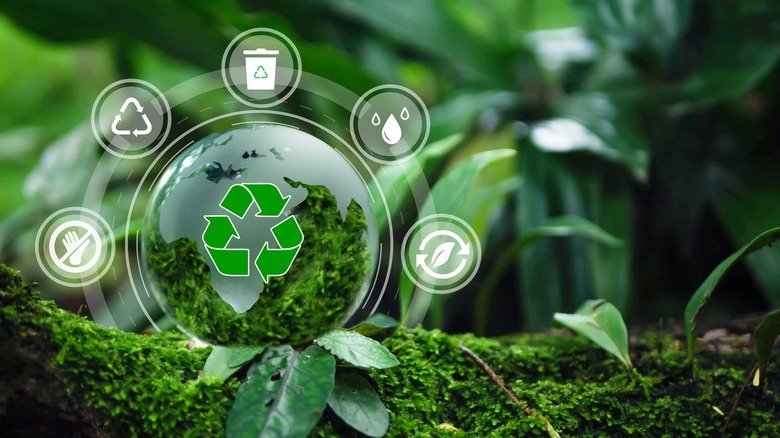
This image is property of www.housedigest.com.
Importance of Sustainable Materials
In addition to using eco-friendly practices, incorporating sustainable materials into your landscaping projects further enhances the overall environmental benefits. Sustainable materials are those that have a minimal impact on the environment during their production, use, and disposal phases.
Choosing recycled and renewable materials
When constructing outdoor structures, such as pathways, patios, or decking, choosing materials made from recycled content or renewable resources is essential. Materials such as recycled plastic lumber, bamboo, or reclaimed wood are eco-friendly alternatives to traditional materials.
Using recycled materials reduces the demand for virgin resources and diverts waste from landfills, contributing to resource conservation and waste reduction.
Benefits of non-toxic garden supplies
By opting for non-toxic garden supplies, such as pesticides, herbicides, and fertilizers, individuals can create a healthier environment for both plants and wildlife. Traditional garden supplies often contain harmful chemicals that can leach into the soil, waterways, and negatively impact the ecosystem.
Choosing organic and non-toxic alternatives minimizes exposure to harmful substances, reduces pollution, and supports a thriving and balanced ecosystem.
Creating Pollinator-Friendly Gardens
Pollinators, such as bees, butterflies, and hummingbirds, play a vital role in plant reproduction and ecosystem health. Creating pollinator-friendly gardens involves selecting plants that provide essential food sources and habitats for pollinators.
Planting native flowers for pollinators
Native flowers, especially those with bright colors and nectar-rich blooms, attract pollinators to your garden. Some examples of pollinator-friendly plants include coneflowers, lavender, bee balm, and butterfly bush. Planting a variety of flowering plants that bloom at different times throughout the year ensures a continuous food source for pollinators.
Providing nesting habitats for bees and butterflies
Beyond providing nectar-rich flowers, creating nesting habitats for bees and butterflies is essential. Installing bee houses, leaving patches of bare ground for solitary bees, or planting host plants for butterfly larvae can support the reproduction and survival of these valuable pollinators.
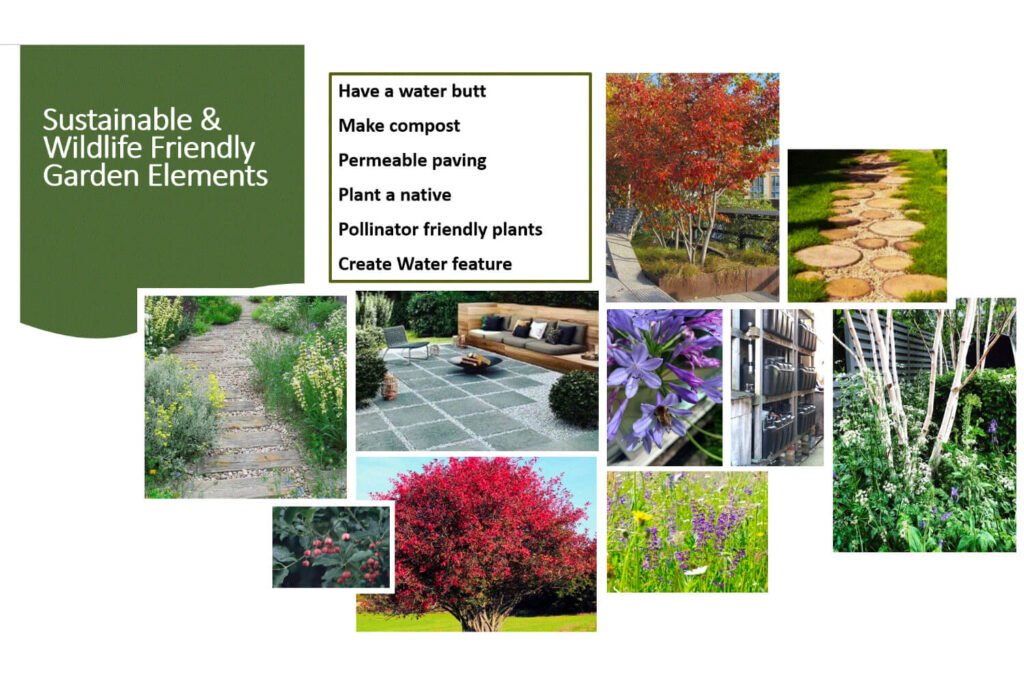
This image is property of designheights.co.uk.
Encouraging Wildlife in the Garden
Creating a garden that welcomes and supports wildlife contributes to a balanced and healthy ecosystem. By incorporating elements that attract wildlife, individuals can enjoy the presence of birds, butterflies, and other beneficial creatures.
Bird feeders and birdhouses
Installing bird feeders and birdhouses provides a steady food source and shelter for birds, encouraging them to visit and inhabit your garden. Different feeders and houses can attract various bird species, adding biodiversity and beauty to your outdoor space.
Creating water features for animals
Water features, such as birdbaths or small ponds, serve as watering holes for a variety of wildlife. They provide drinking water for birds, amphibians, and other small animals, enhancing the overall ecological value of your garden.
Low-Impact Irrigation Systems
Water conservation is a critical aspect of green landscaping. Implementing low-impact irrigation systems can ensure that plants receive adequate water while minimizing water waste.
Benefits of drip irrigation
Drip irrigation systems deliver water directly to the base of plants, reducing evaporation and water loss due to runoff. By providing water directly to the plant’s roots, drip irrigation promotes efficient water usage and reduces the risk of overwatering.
Smart irrigation controllers
Smart irrigation controllers use weather data and sensor technology to determine when and how much water is needed for the landscape. By adjusting irrigation schedules based on weather conditions, these controllers prevent overwatering and reduce water waste, leading to significant water savings.
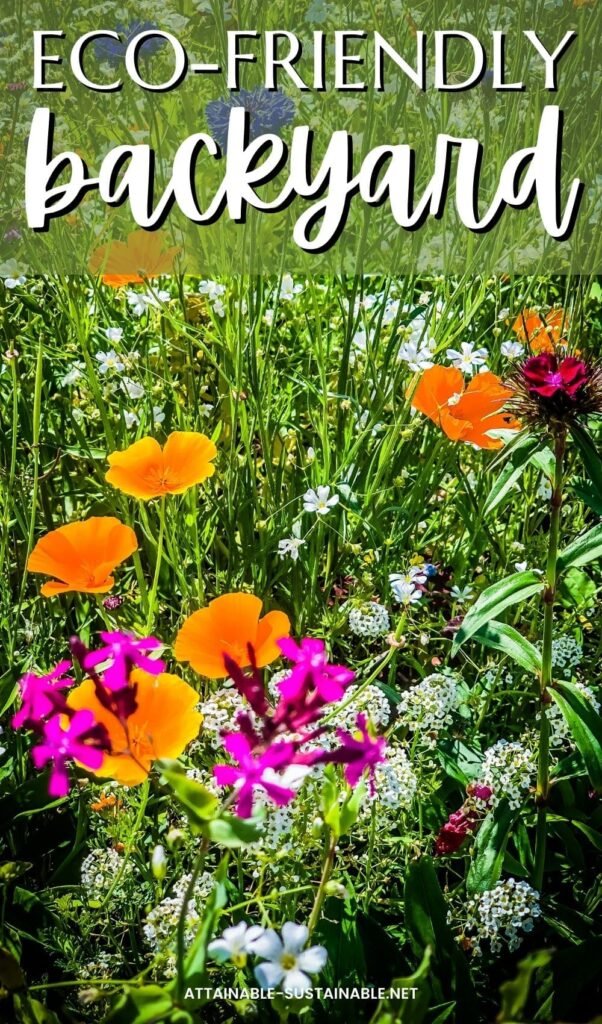
This image is property of www.attainable-sustainable.net.
Education and Community Involvement
Promoting green landscaping awareness and encouraging community involvement are essential for creating a sustainable and eco-conscious environment. By educating yourself and those around you, you can inspire others to embrace green landscaping practices and make a positive impact.
Promoting green landscaping awareness
Spreading awareness about the benefits and importance of green landscaping can be done through various channels, such as social media, community events, and educational workshops. By sharing your knowledge and experiences, you can inspire others to embrace eco-friendly practices in their own outdoor spaces.
Organizing workshops and community projects
Organizing workshops, webinars, or community projects focused on sustainable landscaping practices can empower individuals to take actionable steps toward creating more eco-conscious gardens. These events can cover topics like composting, native plant selection, water conservation, and the use of zero emission tools.
Conclusion
Embracing green landscaping and incorporating zero emission tools into your outdoor maintenance activities can have a significant positive impact on the environment. By reducing pollution, conserving resources, and promoting biodiversity, you can create an eco-conscious garden that is both beautiful and sustainable. With a little effort and the right tools, you can play a role in building a healthier and greener future for our planet. So, go ahead and embrace green landscaping – your garden and the environment will thank you for it.
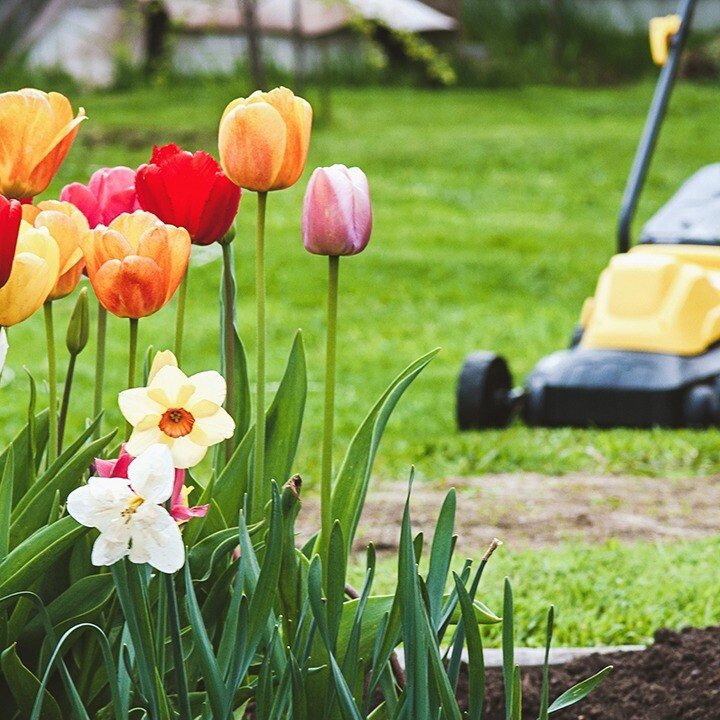
This image is property of www.ecogardeners.com.

